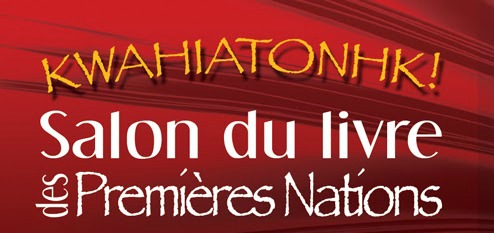By Linda Handiak
“Talking circles are based on the sacred tradition of sharing circles. Indigenous peoples of Turtle Island have used such circles to communicate, solve problems, and provide healing since time immemorial.” (trentu.ca)
If you want to engage in a stimulating conversation with Indigenous writers, register for the November Salon du livre des Premières Nations in Quebec City. Although it is advertised in French, the annual 3-day line up features such luminaries as David A Robertson, Springboard’s 2024 keynote speaker, and Waub Rice, author of the nailbiter, Moon of the Crusted Snow, a new staple on some high school reading lists. Moreover, many of the presenters who write in French have had their books translated into English, and their books can be purchased on site.
Not only do I go to stock up on novels, poetry anthologies and lovingly illustrated children’s books, but also to glean insights from the free workshops. Although several workshops are delivered in French, there are always a few English workshops in session. Audience participation is encouraged at the end of the round table discussions, and authors are available to sign copies of their books. Previous topics have included the power of women protagonists, the importance of Indigenous names and the healing power of the land.
The dynamic round table format of the workshops generates warm camaraderie and animated repartee among the invited authors. Imagine the places you can go when leading playwright and humorist Drew Hayden Taylor discusses world building with internationally acclaimed gothic fiction writer Eden Robinson.The questions posed by this year’s moderators were inspirational for teachers looking for fresh ideas to revitalize literature circles and promote higher order thinking. I have included examples of questions encouraging the metacognitive reflection targeted in the Developmental Continuum For Oracy Skills, embedded in Quebec’s ELA curriculum. These metacognitive skills include reflecting on one’s strategies as a communicator and recognizing one’s contributions and impact. Students could start by answering these questions in the persona of an author, since it is easier to model themselves on the answers they researched. This process also encourages them to consider how background and environment shape writing. They could eventually move on to asking each other these questions about their own writing.
Questions about the writing process
The moderator asked children’s and YA authors if they started with images or words.
Inuk writer, Oceanne Kitura Bohemier-Tootoo, for example, saw her children’s book, Trouver La maison, in pictures before she put words to it.
The writers were also asked how they managed to keep their observations fresh, as though being seen through a child’s eyes.
Valerie Richer O’Bomsawin noted that her grandmother began exhorting her to describe her experiences according to all five senses from a young age. Joannie Gill added that familiar places and cultures may be invisible to you when you are living on the inside. Stepping out of them from time allows you to see them more clearly with new eyes.
YA fantasy writers were asked if they wished characters from their respective works could meet and interact.
Several writers tried to envision how their protagonists might fare in the worlds and planets created by their peers. Others tried to imagine meet-cutes for their protagonists. (Students can set up the heroes from different classroom texts and imagine where those relationships will go.)
Some of the authors were asked if there were questions they wished had been posed.
Some joked that they would like to be asked to collaborate on movies. (Another classroom activity would be to imagine a novel as a movie and justify which actors would play the protagonists). Others said they wanted to share more about their own mentors and about the books they read as children.
Questions about the purpose for writing
The moderator asked how writing helped the authors heal their pain.
For many First Nations authors, writing is not only a way of transmitting culture but is also an act of decolonization and survival. Cyndy Wilde, Virginie Pésémapéo and Carolle Labarre described how writing helped them exorcize and heal the injustice they witnessed and experienced as Indigenous women. Labarre remarked that she could rage all day or she could write books, like L’or des mélèzes, which gives voice to a resilient Innu Elder. These strong, articulate women believe that the very act of recording their stories is an act of resistance.
Two former chiefs were asked what would be the best compliment they could get from a young person.
Raphael Picard and Konrad Sioui had recently turned to writing as a way of preserving their culture and articulating their hopes for the future. They described the analogy of a traditional circle, where the fire burning at the center can reach everyone equally. They hoped that even those sitting at the outer edges of these round tables felt ignited to read more, know more and do more to promote inclusion and justice.
I was inspired to stock up on books, such as Take Me to Your Chief. It is a diverse collection of YA suitable Sci Fi stories by Drew Hyden Taylor. The one about AI is eerily topical. My other Drew Hayden Taylor pick was for my own indulgence, a clever Trickster romance called Motorcycles & Sweetgrass. I also purchased Nish: Northern Lights, the story of Innu teen twins navigating life away from their hometown.
For more information: https://kwahiatonhk.com/
